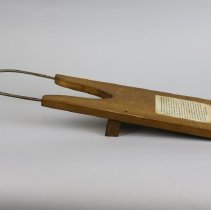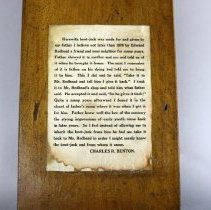Object Record
Images



Metadata
Object Name |
Bootjack |
Catalog Number |
2019.fic.236 |
Description |
Wooden bootjack with wire hoop on the raised end. The board has a U-shaped opening on one end and an attached angled block of wood on the under side. Glued to the top is a history of this object. |
Provenance |
According to the donor, Charles R. Benton, the bootjack was given to his father Charles S. Benton about 1878. It was made by Edward Redhead, a carpenter in La Crosse from about 1870 to 1900. |
Used By |
Benton, Charles S. |
Made By |
Redhead, Edward |
Owned By |
Benton, Charles R. |
Date |
c. 1878 |
Material |
Metal/Wood |
Dimensions |
H-4.25 W-5.88 L-23.5 inches |
Length (in) |
23.500 |
Height (in) |
4.250 |
Width (in) |
5.880 |
Place of Origin |
La Crosse, WI |
People |
Benton, Charles |
Subjects |
"Things that Matter" |
Search Terms |
"Things that Matter" |
Notes |
Featured in Things that Matter: Anyone who has worn boots knows how hard it can be to take them off at the end of the day. You must either sit down, or stand on one leg, grab the boot with both hands, and pull hard. Muddy or wet boots make the job that much harder. Boot jacks like the one in this photo are handy devices that assist you in the process of removing your boots. Simply place the back of your boot into its U-shaped opening and place the toe of your other foot at the back of the jack. Then pull your foot out of the boot. Repeat the process for the other boot. It’s a simple tool that makes life a bit easier. This boot jack was made in the 1870s by a La Crosse carpenter, Edward Redhead, and given to his friend Judge Charles S. Benton. It is made of pine, and has an added feature of a wire loop that helps to keep the boot in place as you lift your foot out of it. Redhead was certainly aware that his was a practical gift for a man of his era. In those days horses provided most commuter transportation, the streets were made of dirt, and much of our population worked in agriculture. Redhead also knew the county judge had tried his hand at farming. Translated into everyday life, that means wearing a pair of boots to protect your feet from lots of dust, mud and the ubiquitous horse manure. The boot jack allowed you to remove your dirty boots hands-free — generally on the back steps, of course. Devices of this type have been around for many years. The U.S. Patent Office lists more than 200 patents for boot jacks since 1852. They can be made of iron, brass, wood and even plastic. Some are simply made, cut out of wood like this jack. Others were made into decorative forms like insects, steer horns or even a naughty lady. Many contained advertising and were given away. Not many people wear boots these days, and when they do, more often they’re worn as a fashion statement. Cowboys, farmers, bikers and military personnel need to wear boots, and many of them have and still use boot jacks. But with the popularity of sneakers and other casual shoes, the boot jack is no longer a typical household appliance. Judge Benton’s boot jack was donated to the La Crosse County Historical Society about 1930 by his son, Charles R. Benton. The younger Benton wanted to be sure his father’s boot jack would not be forgotten, so he printed its story and glued it to the base. This article was originally published in the La Crosse Tribune. Title: Judge Benton's Boot Jack Author: Robert Mullen Publish Date: January 4, 2020 |